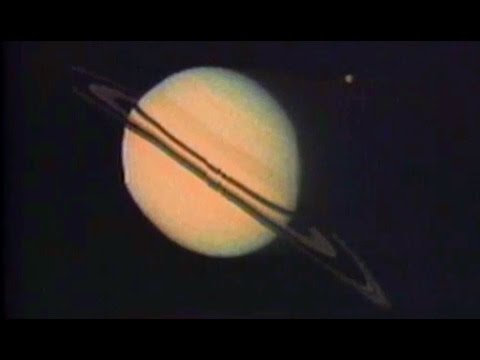video for embedding at
NASA Television coverage of the Pioneer 11 Saturn flyby in October and November, 1979. The mission was run by the Ames Research Center in California.
Reupload of a previously uploaded film, in one piece instead of multiple parts, and with improved sound.
Public domain film from NASA, slightly cropped to remove uneven edges, with the aspect ratio corrected, and mild video noise reduction applied. The soundtrack was also processed with volume normalization, noise reduction, clipping reduction, and/or equalization (the resulting sound, though not perfect, is far less noisy than the original).
PIONEER SATURN RESULTS ARE SUMMARIZED (1979)
NASA’s Pioneer 11 spacecraft continues to work well after successfully flying past Saturn, the most distant planet yet reached in U.S. exploration of the solar system…
After a six-year trip of more than 3.2 billion kilometers (2 billion miles) in space. Pioneer spent 10 days photographing and measuring the ringed planet. As it made its closest approach, Sept. 1, to within 20,800 km (13,000 mi.) of Saturn’s cloud tops at a speed of 114,500 km/hr (71,200 mph) some 1.6 billion km (1 billion mi.) from Earth, Saturn’s gravity swung it almost 90 degrees on a change of course toward the edge of the solar system…
• Saturn has an 11th moon. It was discovered in a photo taken of the outer edge of Saturn’s rings and by instrumentation on board the spacecraft. Its estimated diameter is 400 km (250 mi.). It has been named 1979S1.
• Saturn has a magnetic field, magnetosphere and radiation belts. It joins Earth and Jupiter as a magnetic planet.
• Because of the low temperature measurements, evidence for the possibility of life on the planet’s satellite Titan was discouraging, but noj: eliminated.
• Two new rings have been identified. One, which has been called the F ring, is separated from the A ring by a 3,600 km (2,240 mi.) gap, called the Pioneer division. The F ring was clearly visible in a closeup picture taken some 943,000 km (586,000 mi.) away from the planet. A second ring, the G ring, also was discovered and lies between the orbits of the satellites Rhea and Titan or about 500,000 km (312,500 mi.) from the cloud tops.
• A feature called the French Division, a division between the middle and inner visible rings (B and C rings), was seen in Pioneer pictures of the shadow of the rings on Saturn’s surface. It was named after French astronomers who first suggested its presence.
• Substantial particle material was seen in Cassini’s Division and in the outer and inner portions of the A ring. The Cassini Division looks empty when viewed from Earth, i.e., from the sunlit side of the rings…
• Preliminary measurements of the ring mass indicate they have a low density. This suggests they are made up largely of ice…
• Gravity field analysis and temperature profile measurements suggest that the planet’s core, extending out about 13,800 km (8,575 mi.) from the center, is about twice the size of the Earth, but is so compressed by Saturn’s huge mass that it contains about 11 Earth masses of material, largely iron and rock.
• Above the core, out about another 21,000 km (13,125 mi.), the measurements suggest that the planet consists of liquid metallic hydrogen, which does not exist on Earth. The presence of liquid metallic hydrogen is supported by the discovery that the planet has a magnetic field. To produce this field, a planet needs fast rotation and a liquid electrical conductor in its interior — in Saturn’s case, liquid metallic hydrogen…
• The planet has radiation belts made up of high energy electrons and protons which are comparable in intensity to those of the Earth, although the region they occupy is about 10 times larger. They are several hundred times weaker than Jupiter’s…
• Titan was found to have a cloud top temperature of -198 C (-324 F.). This very cold temperature eliminates an internal heat source as a means of warming Titan’s surface, but leaves the possibility of atmospheric heating from a greenhouse effect.

